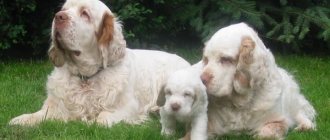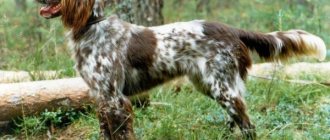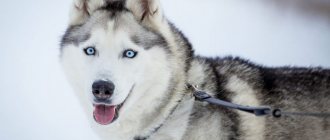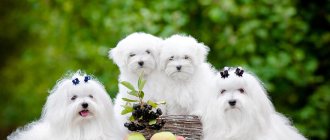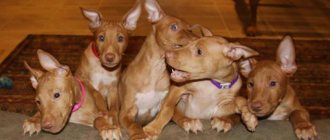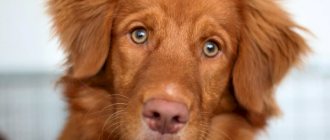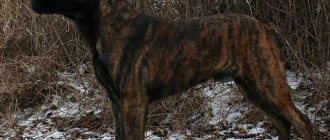In this article we will tell you about the most popular breeds of cop dogs, among which you will find the one that is right for you.
This subspecies of pets has the following qualities:
- loyalty;
- obedience;
- endurance;
- persistence;
- savvy;
- ease of training and training;
- aggression towards prey.
It is interesting to know that pointing dog breeds are not only the best hunters, but also good family protectors. Therefore, with proper training, they can be used to protect homes.
Features and types of cops
Pointing dogs are usually of medium height and have a strong build with little fat. They most often have soft and floppy ears. These breeds are in great demand among hunters, and the dogs can also make excellent companions.
Traditionally, all breeds of pointing dogs are divided into two large groups:
- island
- continental
Due to the popularity of gun hunting among the European nobility in the Middle Ages and Modern times, each country on this continent developed its own breeds of cops. There are especially many of them in Germany and France.
general information
Hunting work is the original and main purpose of pointing breeds. But recently, such dogs often become companions, and, with appropriate training, good guards. All breeds of cops in the FCI catalog are combined into the seventh group.
Exterior and character
Coping breeds are characterized by medium size and a strong muscular build; they have practically no subcutaneous fat. Also, the general external features of these dogs include the following exterior features:
- elongated muzzle;
- drooping ears;
- smooth, streamlined body lines;
- dense skin and a coat that fits it - the hair can be either short or long.
Exterior features allow the cop to work effectively both on land and in water
Hunting gun dogs have a common set of qualities, each of which is an undoubted advantage:
- loyalty;
- obedience;
- endurance;
- persistence;
- savvy;
- ease of training and training;
- aggression towards prey.
Loyalty to the owner is the main quality for all pointing breeds
Genetically fixed features
A characteristic feature of pointing breeds is the presence of behavioral characteristics that are genetically fixed. First of all, this concerns the working qualities of the dog. Having discovered prey, all cops freeze like a sculptural statue: the nose is directed towards the game, the body is tense and motionless, the tail is extended. This stance is genetically fixed in all working breeds and is their main feature. The dogs know that they must stand still and not fuss, so as not to inadvertently get shot.
Most cops learn easily and with pleasure
Among the innate hunting qualities that most cops are endowed with are also the ability to retrieve game (fetching) and, of course, the ability to find it using the famous upper sense.
Photo gallery: innate qualities of working pointing dogs
Having smelled the game, the pointer quickly moves in its direction.
The “signature” stance indicates the hunter the direction in which to look for prey.
Having realized its hunting instinct, the dog does not eat the prey, but brings it to the person
Ariège braque
This relatively young breed of cops was bred at the turn of the 19th and 20th centuries. Its homeland is the region of the same name, located in the foothills of southern France.
The Ariège Braque is a fairly tall dog, reaching 56-67 cm at the withers and weighing about 25-30 kg. On an elongated, proportional head with a slightly pronounced stop, there are oval dark eyes and hanging, close-fitting ears. The harmoniously developed body with a straight topline, strong neck and deep chest is covered with short, smooth hair of brown or pale orange-fawn color. The standard also allows for the existence of white individuals with chocolate markings.
The Ariège Braque is a reserved, balanced and very obedient dog. He does not show causeless aggression, but is quite restrained towards strangers. He easily gets along with his relatives and has excellent hunting qualities.
Russian-European. Description of representatives
The Russian-European Laika is a dog of medium height (52-58 cm), strong build and lean constitution, agile and lively, with well-developed muscles. She has a wedge-shaped head with a wide skull, the muzzle is shorter than the length of the skull, the transition from the forehead to the muzzle is hardly noticeable, the cheekbones are clearly defined. The eyes are cheerful, oval, with a slight slant, and the ears are triangular and erect. The legs are straight and level, the tail is curled and pressed to the back or thigh. The coat is coarse and thick, long and straight, with a dense soft undercoat. There is a lush collar of wool and scruff on the neck, shoulders and withers. On the hind legs the hair is longer and shaped like pants. Colors include black, piebald, white, red and zonular.
The dog has a very friendly character, is very independent and balanced, it is characterized by agility and playfulness, devotion and loyalty to the owner. It should be washed and bathed only when necessary, since dogs are very clean and tidy.
Story
All cops have ancestors of the ancient dogs of Europe, with which man has hunted birds since ancient times. An ancient dog, having found prey, lay down next to it, hence the name of the group of breeds - “coping dog”.
Initially, pointing dogs that appeared in Spain had long hair, but over time they became short-haired. Then they stopped lying down and began to make a beautiful stand.
Gradually, continental cops learned to bring game to the feet of the owner (port) from land and from water, stand on the hare, follow the trail, etc., and became even more in demand among hunters.
Historical roots
Breeds of pointing dogs
Even ancient hunters noticed that individual dogs, sensing the lying of an animal or a hidden bird, froze, stretched out in that direction. Already more than two thousand years ago these habits were used.
Modern pointing dogs are descended from ancient European hunting dogs that assisted in bird hunting with nets. Having found the game, this dog lay down in front of it (hence the name “copper”), and the hunters threw a net over the victim and the dog. Later, hound breeds were used to breed such pets, so they acquired the property of making a stance when a victim was detected.
Note! English dog breeders called the pointers pointers, which translated means “pointer.” The special stance of such breeds has been cultivated and consolidated over centuries through artificial selection. Today, this quality is fixed at the genetic level and does not require special training.
Cop stance
Today, this quality is fixed at the genetic level and does not require special training. Cop stance
With the invention of firearms, the popularity of such pets has increased significantly. Nowadays, a pointing dog is a faithful companion that indicates the location of the victim for the hunter, pursues an escaped wounded victim, and brings it to the owner.
Griffons
A group of breeds belonging to subsection 1.3.
French Wirehaired Pointer Griffon
The breed received its second name, the Korthals Griffon, thanks to its creator, who set the goal of getting the most intelligent and hardy of the cops. The basis was taken from the best representatives of the hunting type.
The dog turned out exactly as the breeders wanted - tall, light, agile, smart. But due to the high cost and strict control over breeding, the breed did not become widespread and today is quite rare in our country.
Advantages of pointing dogs
Cops are considered descendants of hound dog breeds. They are similar in appearance and behavior. They differ from them only in their extremely keen sense of smell and ability to stand in front of the game.
Here are the main character traits of cops:
- There is no aggression towards humans in almost all breeds
- They prefer to hunt independently rather than in a pack
- Have a labile, mobile nervous system
- Easily switch attention while hunting
- They have their own search style and hunting stance.
Training
Training is a mandatory requirement for keeping cops. Movement will ensure proper blood circulation in the animal’s body and strengthen the muscle corset. Without regular training, the animal will not be able to do its job while hunting.
The breeder regulates the duration of training, taking into account the condition of the dog. The first classes are carried out without excessive stress; pets who have recently suffered from an illness also need gradual training.
The breeder’s task is to teach the pet basic commands, conduct classes on training for game, and study the basic signal stances with the animal. Inexperienced dog owners are recommended to seek the help of experienced dog handlers for training.
Breton epañol
Or, as it is also called, the Epagnole Breton is an active, hard-working breed whose representatives can work in any weather. Epagnoles are unsurpassed hunters of partridge, pheasant and wild duck. They listen to their owner unquestioningly and can pursue the victim for a long time.
It will be useful for you to know: what are the reasons for licking dogs' paws, how to choose toys and harnesses, how to make a booth and enclosure with your own hands, what is inbreeding, trimming and grooming of dogs.
Representatives of this breed are distinguished by their playful character, gracefulness and ease of upbringing (they are loyal, obedient and open).
Island Pointer Breeds
English Setter
English Setter
Height: 61-68 cm.
Weight: 20-25 kg.
Country of origin: UK.
The English Setter is a very beautiful and elegant breed of pointing dog, a direct descendant of the ancient hunting dogs of Europe, which were used to hunt with nets in the Middle Ages until the advent of the hunting rifle.
With the advent of firearms, English setters also improved for the better: they learned to run much faster and stand up more beautifully. Eduard Laverack played a major role in the formation of the breed and its standard.
It was thanks to him that a purebred English setter was born, which was named Laverack in honor of the father of the breed. This is a very aristocratic breed of dog with an elegant physique, calm and good-natured character.
Scottish Setter
Height: 62-66 cm.
Weight: about 29 kg.
Country of origin: UK.
This beautiful black and tan setter is the result of crossing English Setters and Pointers. The breed was formed and described in the mid-60s of the 19th century.
This is a very hardy dog that is capable of hunting in the most difficult terrain. He has an excellent sense of smell, but requires long and painstaking training. She can be kept in a city apartment, but needs constant walking.
The Scottish Setter requires periodic brushing and bathing. He constantly requires the attention of his owner and family, he is a wonderful companion and a wonderful friend. It cannot be alone, sitting on a chain as a watchman.
English pointer
Height: 61-69 cm.
Weight: 20-34 kg.
Country of origin: UK.
This is a fairly large setter, in which the blood of a foxhound, bulldog and even a greyhound flows. The first standard of the breed was formed only at the end of the 19th century, although it has been bred for at least two hundred years.
The breed is divided into light and heavy types. Even in the second case, this is a slender and graceful dog with very great dignity. By character, like all Englishmen, she is a phlegmatic person in a calm state, and a real choleric person in an excited state.
The English Pointer has an excellent nose, he is a natural hunter, and therefore constantly needs walks in fields and forests. The dog has the ability to search widely and has an excellent strong stance.
Irish Red Setter
Irish Setter
Height: 55-67 cm.
Weight: 27-32 kg.
Country of origin: Ireland.
These setters come from Ireland and developed as a separate breed in the mid-19th century. The Irish Setter appeared in Russia a long time ago, but it is difficult to train due to its proud nature.
It is worth noting that Russian dog handlers and breeders became interested in these pointers and developed their own improved breed of Irish setters. As a result, it became much easier to communicate and get along with them.
This is a very beautiful and elegant dog with a high stance. It can be used in summer and autumn for hunting in the steppe, swamps and forests. With proper upbringing, it demonstrates miracles of training.
Irish Red and White Setter
Height: 57-66 cm.
Weight: 15-30 kg.
Country of origin: Ireland.
This is another popular Irish pointer specializing in hunting game birds. She simply loves hunting and needs a large rural space and regular exercise.
This setter is completely tireless in searching for game, has a beautiful stance, and an innate ability to fetch. A good bird hunter simply cannot find a better assistant. The Irishman is not aggressive towards people and pets.
If you just need a companion, then this dog is very friendly and good-natured, and will quickly find a common language with children. Just don’t forget to walk her through the forests and fields longer, otherwise she may become sad and get sick.
East Siberian Laika
This breed is a hunting breed, it is multifunctional: it is capable of hunting both squirrels and deer. It is distinguished by a large, strong body, it is the largest among its brothers, reaching 53-65 cm at the withers. It is hardened by frosts and the north, and is tireless in work. Like all Laikas, the breed belongs to the 5th group and 2nd section: Spitz and primitive type breeds, northern hunting dogs. Homeland - Russia. The dog was officially registered in 1949.
The animal has an elongated format, although most of its brethren are square. Strong paws, bones, and head help the dog survive in low temperatures, squally winds and hard work. The standard describes the following external characteristics of all huskies:
- The head is wide, massive, wedge-shaped with pronounced cheekbones;
- The muzzle is equal in length to the head, well filled, with strong jaws and a scissor bite;
- The eyes are medium-sized, oval, slanted, brown in color;
- The nose is large and fleshy, always black;
- The ears are erect, triangular, with a medium set;
- The body is long, muscular, with a straight top line, a tucked bottom line, pronounced withers, and an oval loin; The neck is long (equal to the length of the head);
- The tail is long, curved and carried over the back;
- The limbs are long, straight, parallel, with oval, collected paws;
- The coat is medium length, hard, straight, with a soft undercoat;
- Colors: black, white, piebald, black and tan, red, gray, brown.
For this breed, it is preferable to be kept in an enclosure or outdoors; if the range is free, then the animal should be on a soft long chain (prone to escape). The main criterion for proper care is long active walks and hunting. It is best to use such a pet for its intended purpose; it will not become a sofa pet.
The cost of the rare Siberian breed may surprise you because it is significantly lower than other exotic dogs. Without a pedigree, a puppy will cost 7,000-10,000 rubles, a pet-class or breeding class pet - 15,000 rubles, a show class - from 20,000 rubles. It is worth noting that the price for adult Laikas depends on their working qualities. A dog that hunts large animals will cost more than one that hunts small fur.
Weimaraner
The homeland of this pointing dog breed, the photograph of which is posted just below, is a small town located 25 km from Erfurt. Its breeding was carried out by noble people who solved important state issues. The breed received official recognition in 1897.
The Weimaraner is a tall, dry dog whose height is 59-69 cm at the withers. The harmonious, sculpted head with a pronounced nape and elongated muzzle has slanting yellow or isabella eyes and high-set drooping ears. The long, athletic body with a deep chest and sloping croup is covered with long or short hair of silver-gray, mouse or roe color.
The Weimaraner is a sociable, good-natured and playful dog with a well-expressed hunting instinct. He gets along well with children and is quite trainable. As for hunting, such a dog demonstrates the most effective work in flat and wooded areas.
Drathaar
The birthplace of this wire-haired breed of pointing hunting dogs is Germany. It was bred to track, pursue and serve game birds and is still successfully used for its intended purpose.
The Drathaar is an elegant, well-balanced dog, growing to 57-68 cm and weighing no more than 32 kg. On a fairly large, flattened head with developed eyebrows and a wide bridge of the nose, there are rounded dark eyes and high-set drooping ears. The strong, muscular body of an elongated format is covered with a hard awn with a dense, thick undercoat. As for the color, it can be plain, black or brown-piebald.
Drathaar is a versatile hunting dog with an extraordinary character. He is very hardy, unpretentious, dynamic, persistent and strong. He needs early socialization and special training. An untrained dog can get carried away chasing a cat or bird and get lost. Therefore, an insufficiently trained drathaar should not be let off the leash.
Continental Pointer Breeds
German Shorthaired Pointer
German Shorthaired Pointer
Height: 58-66 cm.
Weight: 20-32 kg.
Country of origin: Germany.
This is a German shorthaired pointer, bred in Germany from older German breeds of pointers that previously hunted birds with nets. Later they became more versatile and learned to hunt with a gun.
Today, this popular breed continues to be improved by breeders; the dogs are able to carry out all hunting commands even in old age. The color can be very different: from deep black to coffee with many spots.
The shorthaired pointer can hunt birds and small animals. He does best hunting in the field, he swims beautifully even in icy water, brings game to the feet of his owner, follows a trail of blood, etc.
German drathaar
Height: 57-68 cm.
Weight: 23-32 kg.
Country of origin: Germany.
This breed of pointing dog was bred in Germany at the end of the 19th century. She is of medium height and brown in color with spots. The drathaar's tail is usually docked if the dog is to be used for hunting.
The breed is very popular among hunters all over the world. She perfectly hunts not only birds, but even wild boars, taking a stance or barking at the animal if necessary.
The hard coat protects the drathaar from the cold and insects. In search of a shot bird, it swims beautifully even in cold waters. Never shows any aggression towards people, good friend.
Hungarian Vizsla
Hungarian Vizsla
Height: 54-64 cm.
Weight: 20-27 kg.
Country of origin: Hungary.
This Hungarian pointer is considered one of the smartest and most talented dogs in the world. In addition, she has a very impressive appearance and an elegant gait. The ancestors of this dog appeared in the Carpathians in the 10th century with the nomadic Magyar tribes.
Their bright red or gold color attracted the Hungarian nobility. The dogs were their absolute favorites not only for their beauty, but also for their excellent hunting talents: a keen sense of smell, excellent stance, the ability to hunt anywhere, etc.
The Hungarian Vizsla is of average height and has a beautiful, muscular build. This is a very good-natured and friendly dog that shows virtually no aggression. He loves an active lifestyle and requires constant walks and exercise.
Italian bracque
Height: 55-67 cm.
Weight: 25-40 kg.
Country of origin: Italy.
This is an Italian pointer, which is used for hunting birds, although it is a universal hunter, it can also hunt rabbits. Italian breeders believe that the Braccus appeared in the 4th century and is descended from the Molossians.
Bracchi were extremely popular among the noble families of Italy during the Middle Ages. Back then, bird hunting was considered a sign of aristocracy. And at the end of the 19th century, these dogs almost disappeared. It took a long time to restore the breed.
The standard for the Italian cop appeared only in the middle of the 20th century, at which time it was officially recognized. This is a very strong and passionate dog that is simply eager to hunt. In between hunts, she can be a wonderful companion.
Weimar pointer
Weimar pointer
Weimar Pointer Weimar Pointer Height: 57-70 cm.
Weight: 30-40 kg.
Country of origin: Germany.
The ancestors of the Weimar pointer hunted big game hundreds of years ago. She has a high level of intelligence, is well trained and obeys her owner. This breed appeared, was recognized and registered at the end of the 19th century.
The Weimar Pointer is of medium to tall height and has a harmonious, muscular build. Color – antique silver. That is why the dog has the nickname “silver ghost” in Germany.
The Weimaraner is a very active dog that loves to learn and perfectly absorbs new material. She is mobile, active, and loves to always be ahead. The good-natured and gentle Weimar Pointer never shows aggression towards humans.
How to choose a puppy?
Breeders of hunting dogs should know that the basic qualities are present in animals from birth. However, they need to be developed and directed in the right direction. When choosing a dog for hunting, first of all you need to study the characteristics of the breed you like, since they are usually divided into universal ones, suitable for searching for game in water and on land.
When considering existing breeds, your preferences should also be based on the further maintenance of the animal. So, there are cops who simply cannot live in a city apartment, since they need space and physical activity. An important factor will be the size of the dog for ease of maintenance.
When purchasing not only your favorite pet, but also a faithful hunting assistant, you should choose a reliable nursery. It is unlikely that you will be able to purchase a good cop at the poultry market. Online shopping is also not worth considering. When choosing, you should personally visit the nursery, evaluate the situation and maintenance of the animals. Ideally, see the parents of the puppy you like. The emphasis should be on the behavior and health of the pet to exclude the presence of congenital diseases.
Pointers are dogs for aesthetic hunters. They are graceful and have an excellent sense of smell, but in searching for wounded animals they may be inferior to other four-legged animals.
Spaniels and Russians are most often purchased for working with game birds, including land and water.
Shorthaired Pointers, Setters, Drahthaars and the Navarrese Pointer combine almost all the qualities of hunting dogs, and therefore are more popular.
Spaniels
In the standard they belong to subsection 1.2
Epagnol
Breton (Breton) Epagnole is the result of working with English setters. The dog turned out to be a smaller and slightly modified version of its ancestor. This is a hunting gun pointing dog with developed intelligence and a cheerful disposition.
Then the breeders were inspired by the result of the work, and they bred several more breeds of Epagnoles, each of which was recognized:
- Pont-Odemer - a super-hunter and a merry fellow, who was nicknamed “the clown from the swamps”;
- Picardy - a dog with a very keen sense of smell;
- Blue Picardy is an excellent hunting and companion dog;
- The Frenchie is the most docile among hunting spaniels.
German langhaar
The breed is also called the German Longhaired Pointer, which appeared as a result of breeding work with French and German spaniels. Later, the blood of setters was added to the Langhaars, which made the representatives of the breed taller.
In our time, this type of pointer remains a hunting dog, which, having spent energy while working, becomes affectionate and obedient at home.
Rare, unrecognized cops of this group
These included large and small Munsterlanders, Drente Epagnoles, and Stabyhunes. But the widespread Russian hunting spaniel, unfortunately, has never received international recognition, although the dog is successfully used both at home and abroad.
Basic moments
- The breed is registered by the RKF, but has not received recognition from the International Canine Federation. In 2002, for the convenience of foreign breeders, the Russian Spaniel Club (USA) was created, which registers litters abroad.
- Despite their hunting qualifications and lively temperament, Russian spaniels easily adapt to city life and happily make forays into nature in their owner’s backpack.
- Breeding of the breed is carried out under the strict control of Russian breeding clubs, so most hereditary diseases have bypassed its representatives.
- Weather conditions do not affect the hunting talents of the Russian Spaniel. This dog can work perfectly in complete calm and even in hot weather.
- The Russian Hunting Spaniel is a born tracker and hunter. At the same time, he has a “non-aggression pact” with cats and other domestic animals with which the dog grew up.
- All representatives of the breed love to swim and are not afraid of cold water.
- A dog’s stomach is a “black hole” in which gigantic amounts of food disappear without a trace.
- Russian hunting spaniels are often involved in searching for psychotropic substances and detecting people in emergency situations. According to domestic dog handlers, this is one of the best breeds in terms of flair and search persistence.
- Taking a Russian hunting spaniel as a pet and companion is not prohibited, but it is very undesirable, since it is unlikely that it will be possible to provide the animal with the level of stress and emotions that working with game gives it.
The Russian hunting spaniel is a gambling “scout” with an easy-going character and an insatiable desire for games. Possessing an outstanding sense of smell and a strategic reserve of patience, this long-eared Stirlitz pursues prey to the last, so that hunting with him is always successful and rich in trophies. In ordinary life, Russian spaniels play the role of unpretentious modest people, but standard dog entertainment is also not alien to them. Another insatiable passion of the breed is food, so if you want to bribe your pet, show him a bowl of food. For such a “bribe” a Russian hunting spaniel will move mountains!
English pointer
Experienced hunters claim that this is the best dog in its category. Puppies show instincts at an early age. Pointers have an excellent sense of smell and can run for quite a long time in search of prey.
Puppies need to be raised from childhood, providing them with constant exercise. If such a dog lives in a home and is unable to release its energy, it may become uncontrollable. Pointers must spend a long time outdoors. In addition, they love to swim.
Care
Caring for the Drahthaar is of average difficulty due to the fact that the wire-haired dog will have to be trimmed twice a year. Wire-back hair does not fall out easily on its own, even during seasonal shedding. The dog needs to be helped to renew its coat by plucking overripe hairs. In between this, it is enough to comb the drathaar 1-2 times a week, preferably using a thick brush made of natural bristles. They bathe the dog as needed, usually more often in the summer than in the cold season.
Many people neglect the need to trim the drahthaar, which interferes with the formation of a new hard coat and significantly reduces the protective qualities of the coat.
Your dog's ears should be checked regularly and cleaned as needed, as well as the condition of their paw pads. With good physical activity, the claws grind down on their own and do not need trimming.
You should also pay attention to the condition of the eyes; eyebrows should not touch the cornea and irritate it. To prevent plaque, it is recommended to brush your teeth at least once or twice a week, especially if the dog eats natural food.
Beagle
Representatives of a wide variety of breeds are united under this general name:
- beagles;
- basset hounds;
- Serbian hounds;
- bloodhounds;
- dachshunds;
- English Foxhounds;
- Smaland hounds;
- Austrian hounds;
- black and tan coonhounds;
- harriers;
- large Vendean basset griffons;
- Otterhounds, etc.
Representatives of the breed are united by their hunting behavior - the dog uses its keen sense to find the scent of game and chases after it, barking. Until the victim is completely exhausted or until a human hunter joins the case. Certain breeds of hounds were bred to chase foxes, rabbits, birds and even small ungulates.
As pets, these animals are loyal, obedient, curious and playful. They are distinguished by great intelligence and are easy to train.
Beagle puppy:
B
Basenji
These are true companions for humans, as they easily and quickly become attached to their owner and the rest of the family.
Basset Hound
This is a dog with enormous intellectual capabilities, but at the same time loves to be loved and respected. They have a very calm disposition and do not require serious physical exertion.
Bedlington Terrier
It has a unique appearance, but at the same time the dog is distinguished by the presence of pronounced hunting instincts, while possessing a sense of self-esteem.
White Swiss Shepherd
A guard dog breed, therefore, it has all the characteristics inherent in this function. Does not show aggression towards strangers and animals, including dogs.
Belgian Griffon
It is an indoor decorative breed, but is distinguished by its unique development with a change in character. When a dog is young, it is rather weak and inactive. As an adult, she gains weight as well as muscle mass and subsequently becomes active and cheerful.
Belgian Shepherd
The dog is quite smart and has excellent security characteristics. She has a lively and intelligent look. However, it is not recommended for maintenance by inexperienced or indecisive owners.
Bernese Mountain Dog
This dog has many positive characteristics. This is not only a strong and hardy breed, it is very devoted to its owner and has a good-natured disposition.
Biewer Yorkshire Terrier
A decorative dog breed with a balanced temperament, but at the same time with a strong and strong-willed character. Feels great in the home company of people and animals.
Beagle
At one time, the breed of dogs helped people hunt small but nimble animals. The dog is friendly, smart, affectionate and energetic.
Bichon Frize
This is a naturally cheerful and playful dog. In addition, she is brave and non-aggressive, but at the same time she has a complex disposition that requires education and training.
Bloodhound
This is a true hound breed, extremely active, requiring constant physical activity. Otherwise, he will be able to turn the apartment into a trash bin.
Bobtail
Bobtails, despite their (comparatively) intimidating appearance, are distinguished by their friendly nature and loyalty towards family members.
Bolognese
The appearance of this breed is very attractive and interesting. They love their owners, but are distrustful of strangers.
Border Collie
The breed is an extremely energetic and fast-moving animal, and therefore requires constant physical activity.
Dogue de Bordeaux
A fairly ancient French breed, the ancestors of which are Roman fighting dogs. This breed was originally used to protect human settlements from wolves and bears.
You can't tell by its appearance that this dog has a very friendly character.
Beauceron
The breed is distinguished by the fact that it is quite social, since it is distinguished by its friendliness, both to its relatives and to other animals. The intelligence of this dog is at a high level.
Boston Terrier
This is a dog that has absorbed a lot of both positive and negative qualities. Needs qualified education and training.
Brazilian Fila
Can successfully protect an object that a person has entrusted to him. Shows distrust of strangers and even at exhibitions keeps everyone at a distance, including judges.
Brussels Griffon
Despite its small size, the breed knows its worth, but at the same time they show friendly feelings and love to play.
Bullmastiff
The breed is distinguished by boundless devotion to its owner, but at the same time they behave non-aggressively towards family members, acquaintances and friends, and are wary when meeting strangers.
Bull Terrier
A rather capricious and stubborn dog, therefore it requires a qualified approach to training and education. In addition, bull terriers must be constantly monitored, otherwise they will try to independently expand the boundaries of what is permitted.
Boerboel
These are strong and hardy dogs, with a beautifully built body that requires constant physical activity. For them, daily walks of 5 km are the minimum load.
English Setter
An affectionate, friendly and self-possessed dog with a well-developed natural instinct and feline grace. The ideal bird hunter.
He gets along freely with other pets and feels great in the company of people. He is quite loyal to children, so he becomes a real family friend.
This breed, which originated in England, is characterized by the following external characteristics:
- smart look;
- muscular torso;
- drooping ears;
- short, thick and shiny coat;
- saber-shaped tail.
The main color of setters is white with black, brown or red patches. Did you know? Setters have long been respected. Their descriptions are found in the works of famous authors, and their images can often be found in paintings by great artists.
Animal care
Pay attention to caring for your ears and coat. Be sure to inspect your fur for ticks after going into the forest or hunting.
Check for damage or wounds.
After each hunt, comb the animal’s fur with special brushes, and if the pet is dirty, wipe the fur with a damp cloth or bathe the dog under running water or using animal shampoos.
When deciding to get a hunting dog breed if you have other pets in the house, remember that dogs can perceive them as prey, given their highly developed hunting instinct, so they can harm birds or rodents.
Cats will suffer no less. It is better to keep them separate from other pets, or at least isolate them in separate rooms while you are away.
Every owner must remember that proper feeding and care of the dog are the main factors for maintaining its health and general physical condition!
Boykin Spaniel
A type of spaniel specially bred for hunting in swamps - wild ducks and turkeys. These are highly trainable animals, brave and purposeful hunters. Their small size helps Boykin Spaniels move quickly through sticky terrain and chase waterfowl:
- Boys. Height – 40-45 cm, weight – 15-18 kg.
- Girls. Height 37-42 cm, weight 11-16 kg.
The life expectancy of representatives of the breed is 14-16 years. As pets, they are noted as friendly, energetic, sociable and intelligent creatures. The only thing is that their luxurious fur requires proper care.
Hungarian Vizsla
A large, muscular dog of an aristocratic appearance. It is a universal hunting dog - it works well both in the forest and in meadows. Well suited for hunting on terrain and in extreme weather conditions.
The Vizsla has a calm disposition and makes a wonderful friend. She shows friendliness to all family members. However, with her affectionate attitude, she shows constant vigilance towards strangers and ill-wishers.
If a Vizsla was raised with cats, it will tolerate all felines. Representatives of this breed are easy to train, but do not have an aggressive and persistent attitude.
Otterhound
The Otterhound or Otterhund is a serious hunting dog, especially adapted to hunting otters and beavers. The first information about the Otterhound dates back to the Middle Ages. Dogs of this breed have undoubted hunting talents. In the past and present centuries, the breed has lost its popularity. May disappear in the coming years. There are no more than 600 individuals left worldwide.
The dog is quite large. Males can reach 70 cm at the withers. Maximum weight is 50 kg. Bitches are shorter and lighter by about 10-15%. The dog is smart, well trained, and has a non-aggressive character. But keeping her in an apartment is difficult. The Otterhound requires significant exercise with trips to the forest and long swimming.
